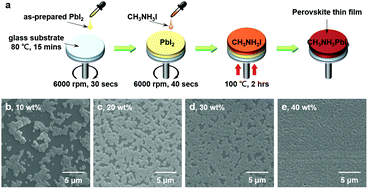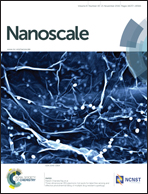Controllable lasing performance in solution-processed organic–inorganic hybrid perovskites†
Abstract
Solution-processed organic–inorganic perovskites are fascinating due to their remarkable photo-conversion efficiency and great potential in the cost-effective, versatile and large-scale manufacturing of optoelectronic devices. In this paper, we demonstrate that the perovskite nanocrystal sizes can be simply controlled by manipulating the precursor solution concentrations in a two-step sequential deposition process, thus achieving the feasible tunability of excitonic properties and lasing performance in hybrid metal-halide perovskites. The lasing threshold is at around 230 μJ cm−2 in this solution-processed organic–inorganic lead-halide material, which is comparable to the colloidal quantum dot lasers. The efficient stimulated emission originates from the multiple random scattering provided by the micro-meter scale rugged morphology and polycrystalline grain boundaries. Thus the excitonic properties in perovskites exhibit high correlation with the formed morphology of the perovskite nanocrystals. Compared to the conventional lasers normally serving as a coherent light source, the perovskite random lasers are promising in making low-cost thin-film lasing devices for flexible and speckle-free imaging applications.



 Please wait while we load your content...
Please wait while we load your content...